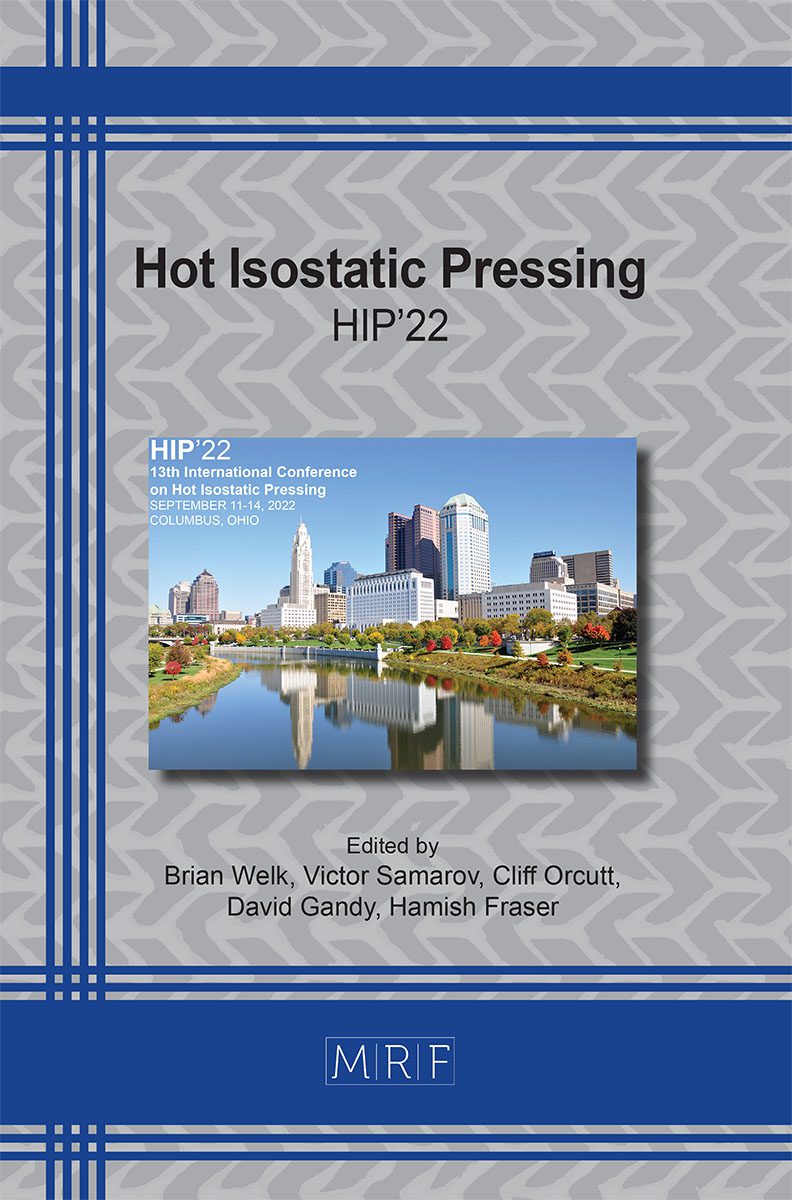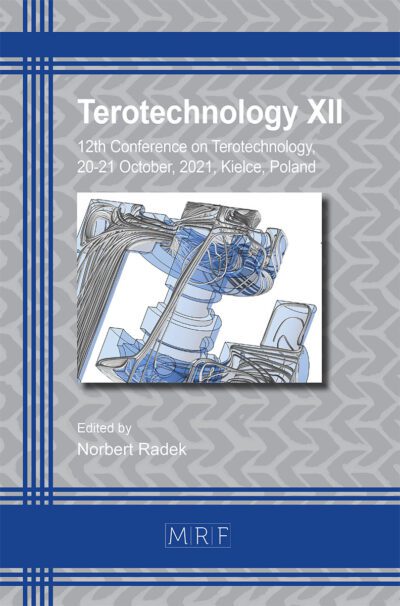Simulation-Based Manufacturing of Near-Net-Shape Components and Prediction of the Microstructural Evolution during Hot Isostatic Pressing
Yuanbin Deng, Anke Kaletsch, Christoph Broeckmann
download PDFAbstract. Following the development of hot isostatic pressing (HIP) with integrated rapid cooling technology, it is now possible to combine consolidation of encapsulated powder and subsequent heat treatment in a single step. In this study, the influences of pressure and cooling rate on the microstructural evolution of martensitic and duplex steels during the entire HIP process with rapid cooling are investigated. Besides the microscopic investigation of the microstructure, a material model for finite element (FE-) simulations was developed to numerically correlate the understanding based on experiments and to predict the final shape of the HIP component. This FE-simulation was additionally employed in the capsule design to achieve net-shape production of the components with complex geometries. The agreement between the experimental and simulated results validated the method to be able to ensure a near-net-shape product and to monitor microstructural development during HIP and rapid cooling.
Keywords
Hot Isostatic Pressing (HIP), Discrete-Element-Method (DEM), Capsule Filling, Finite-Element-Method (FEM), Densification, Phase Transformation/precipitation, Modelling, Simulation
Published online 12/8/2023, 11 pages
Copyright © 2023 by the author(s)
Published under license by Materials Research Forum LLC., Millersville PA, USA
Citation: Yuanbin Deng, Anke Kaletsch, Christoph Broeckmann, Simulation-Based Manufacturing of Near-Net-Shape Components and Prediction of the Microstructural Evolution during Hot Isostatic Pressing, Materials Research Proceedings, Vol. 38, pp 120-130, 2023
DOI: https://doi.org/10.21741/9781644902837-18
The article was published as article 18 of the book Hot Isostatic Pressing
![]() Content from this work may be used under the terms of the Creative Commons Attribution 3.0 license. Any further distribution of this work must maintain attribution to the author(s) and the title of the work, journal citation and DOI.
Content from this work may be used under the terms of the Creative Commons Attribution 3.0 license. Any further distribution of this work must maintain attribution to the author(s) and the title of the work, journal citation and DOI.
References
[1] H. V. Atkinson and S. Davies, “Fundamental Aspects of Hot Isostatic Pressing: An Overview,” Metallurgical and Materials Transactions A, vol. 31A, no. 12, 2000. https://doi.org/10.1007/s11661-000-0078-2
[2] E. Hernández-Nava, P. Mahoney, C. J. Smith, J. Donoghue, I. Todd, and S. Tammas-Williams, “Additive manufacturing titanium components with isotropic or graded properties by hybrid electron beam melting/hot isostatic pressing powder processing,” Scientific Reports, vol. 9, no. 1, p. 4070, 2019. https://doi.org/10.1038/s41598-019-40722-3
[3] T. Pöschel and T. Schwager, Computational granular dynamics: Models and algorithms, 1st ed. Berlin, Heidelberg: Springer, 2010.
[4] P. A. Cundall and O. D. L. Strack, “A discrete numerical model for granular assemblies,” Géotechnique, vol. 29, no. 1, pp. 47–65, 1979. https://doi.org/10.1680/geot.1979.29.1.47
[5] S. Luding, “Introduction to discrete element methods,” European Journal of Environmental and Civil Engineering, vol. 12, 7-8, pp. 785–826, 2008. https://doi.org/10.1080/19648189.2008.9693050
[6] A. Bose and W. B. Eisen, Hot consolidation of powders & particulates. METAL POWDER INDUSTRIES FEDERATION, 2003.
[7] H. A. Kuhn and C. L. Downey, “DEFORMATION CHARACTERISTICS AND PLASTICITY THEORY OF SINTERED POWDER MATERIALS,” Int. J. Powder Metall., vol. 7, no. 1, p. 15, 1971.
[8] M. Abouaf, J. L. Chenot, G. Raisson, and P. Bauduin, “Finite element simulation of hot isostatic pressing of metal powders,” Int. J. Numer. Methods Eng., vol. 25, no. 1, pp. 191–212, 1988. https://doi.org/10.1002/nme.1620250116
[9] B. Wikman, A. Svoboda, and H. Å. Häggblad, “A combined material model for numerical simulation of hot isostatic pressing,” Comput. Meth. Appl. Mech. Eng., vol. 189, no. 3, pp. 901–913, 2000. https://doi.org/10.1016/S0045-7825(99)00406-5
[10] Y. Deng, J.-L. Zhang, A. Kaletsch, and C. Broeckmann, “Modelling and simulation of densification and σ-phase precipitation in PM duplex steel AISI 318LN during hot isostatic pressing,” Materials Today Communications, vol. 29, p. 102901, 2021. https://doi.org/10.1016/j.mtcomm.2021.102901
[11] C. van Nguyen, Y. Deng, A. Bezold, and C. Broeckmann, “A combined model to simulate the powder densification and shape changes during hot isostatic pressing,” Computer Methods in Applied Mechanics and Engineering, vol. 315, pp. 302–315, 2017. https://doi.org/10.1016/j.cma.2016.10.033
[12] S. Riehm et al., “Tailor-made functional composite components using additive manufacturing and hot isostatic pressing,” Powder Metallurgy, vol. 64, no. 4, pp. 295–307, 2021. https://doi.org/10.1080/00325899.2021.1901398
[13] A. Eser, A. Bezold, C. Broeckmann, I. Schruff, T. Greeb, “Tempering-Simulation of a thick-walled Workpiece made of X40CrMoV5-1 Steel,” Journal of Heat Treatment and Materials, p. 127.
[14] A. Eser, Skalenübergreifende Simulation des Anlassens von Werkzeugstahlen. Dissertation, Aachen, 2014.
[15] M. Avrami, “Kinetics of Phase Change III. Granulation, Phase Change and Microstructure,” Journal of Chemical Physics, p. 177, 1941. https://doi.org/10.1063/1.1750872
[16] A. Höfter, Numerische Simulation des Härtens von Stahlbauteilen mit verschleißbeständigen Schichten. Dissertation, Bochum, 2005. https://doi.org/10.3139/105.100294
[17] C. Broeckmann and T. Weißgärber, Schlussbericht Maßgeschneiderte verschleißfeste Verbundbauteile durch Additive Manufacturing und heißisostatisches Pressen (Maß-HIP-3D): IGF Vorhaben Nr.: 21074 BG. Aachen/Dresden, Germany, Herbst, 2022.
[18] D. Girardeau-Montaut, A. Maloney, and R. Janvier, CloudCompare (2019).














